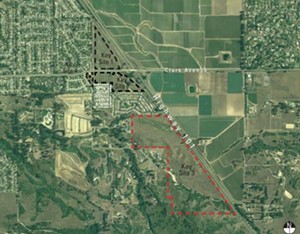Jon Blanchard has lived in Orcutt since 1992, and for the past few years he’s led efforts for trail and open space advocacy through the nonprofit Santa Maria Valley Open Space.

“Our board members are all local Orcutt residents or nearby. They are mostly working people that have jobs in the community, but we build and maintain trails for Santa Barbara County parks. We helped out at Los Flores Ranch and other local trails,” Blanchard told the Sun after returning from a three-day backpacking trip.
Orcutt has plenty of open space, but trail advocates like Blanchard are worried about public access and trail maintenance as housing in the unincorporated area grows under the Orcutt Community Plan: a 25-year-old document that lays out specific areas—or key sites—for housing, commercial use, and community development, as well as guidelines for what must be included in the area as it grows.
The most recent project—known as Key Site 3—was approved 3-2 by the Board of Supervisors on May 3 and would add 119 new residences on a mesa near Clark Avenue at Highway 101, according to county documents. Its approval will provide needed affordable housing to Santa Barbara County, but concerns remain about how the project will impact open space as it moves forward.
Losing space
Blanchard said that Santa Maria Valley Open Space doesn’t support or oppose development projects, rather it reviews project plans for trail opportunities—especially those identified in the Orcutt Community Plan.
Key Site 3 included 113 acres of natural open space and multi-use trails, and presented an opportunity to expand the trail network, he said. However, Blanchard’s still concerned about public access as the original proposal only included five trail parking spaces, he said.
“The county is hoping the road leading to the parking would provide trailhead parking, but I’m not sure if that will happen because I think residents will park on the streets as well,” he said. “If it’s a public open space, then it needs to be open to the public and not an annoyance to the community.”
Although there are opportunities to expand Orcutt’s trail network, Blanchard worries that the trails will get lost in the network of proposed developments—cutting through busy roads or private property—a challenge he saw when Rice Ranch was developed, he said.
“All of these things divide the open space and make it less natural. [Residents] have enjoyed an intact open space for 10 years, but it gets cut up by development. At some point, the development jumped outside its footprint that shouldn’t have been allowed in the open spaces, in my opinion,” he said.
Santa Maria Valley Open Space reached out to the county through public comments and got ahold of 4th District Supervisor Bob Nelson, who Blanchard said was very helpful and advocated for open space as this project worked through the county approval process.
“We have a good relationship with Nelson and work with him all the time, but we see the clock ticking as the community is almost built out. These opportunities are closing up, and the trails and open space are not getting built out,” Blanchard said.
Not fitting the plan
The Orcutt Community Plan requires open space.
“The existing system lacks acreage, facilities, and distribution to serve existing residents. Recreational services are provided by local nonprofits, and often lack widespread availability and specific facilities,” the plan stated.
The plan is meant to address these issues by laying out specific open space requirements for development—including in Key Site 3—but like Blanchard, Nelson said he sees Key Site 3 as stepping on the toes of the community’s open space.
Nelson and 5th District Supervisor Steve Lavagnino voted against the project’s approval. The county Planning Commission recommended that supervisors deny the project, but housing demands and the development company’s consistent efforts pushed the board to approve its plans, Nelson said.
“I’m a pro-development guy; I do support things that are permissible. If it is legal to do it, we have to find a way to do it,” Nelson told the Sun. “[However] it was inconsistent with the plan. As part of the motion, we had to change the community plan.”
Changes included adding more access roads to the site and changing the land use from residential ranchette to planned development, according to county documents. Along with this, supervisors also agreed to several conditions, such as adding 15 to 20 more trailhead parking spaces and installing decorative fencing around a stormwater basin to not disrupt the viewshed.
Nelson said he sees the approval as a step backward because the project has become less consistent with the rest of the community. The development will create a high concentration of homes in one area—with 277 units total from various projects—too dense for the small area and inconsistent with other development in the area, he said.
“The board felt like they needed to take action on it. We need more housing, and they [the developers] have been through the process the whole time. But the rest of the board doesn’t live in my district, and I’ll have to live with that. It’s hard from my perspective,” Nelson said.
Housing demands
Although having wide open spaces and rural aesthetics is important to the Orcutt community, the county does need more affordable housing that complies with preserving natural resources. One of the ways to ensure more public open space is by building higher-density housing, Santa Barbara County Planner Shannon Reese said.
“It’s difficult to balance the need for housing and open space. That’s part of the role for decision makers when they are adopting an environmental document. They are making a decision about housing and economic benefits and weighing that with impacts to natural resources,” Reese said.
Because California is experiencing a housing crisis, the state has mandated that local agencies continue construction in order to meet community needs, including in Orcutt. But by preserving 91 acres of open space and decreasing the number of units from 125 to 119, Reese said the project is consistent with the Orcutt Community Plan.
“That speaks to the balance of resources on-site. They did everything they could to limit the development footprint while still getting almost the number of units that were up for consideration on this process,” she added. “It’s just [challenging] when communities have historically opposed higher density.
“If you aren’t building up, you’re building out to accommodate, and that will affect the county to a larger extent.”
Reach Staff Writer Taylor O’Connor at [email protected].









